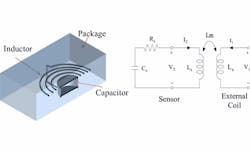When temporary wireless sensors are used for medical applications, multiple surgeries are needed to install and remove the sensor. If a wholly biodegradable sensor were used, the removal surgery would become unnecessary. To save patients a costly and potentially painful second surgery, Mengdi Luo, Adam Martinez, Chao Song, Florian Herrault, and Mark Allen from the Georgia Institute of Technology explored materials to create an RF biodegradable pressure sensor.
Polyactic acid (PLLA) and polymer liquid crystal (PLC) biodegradable plastics were used to construct the films that operate as the sensor substrate. The conductor materials for the inductor coils and capacitor plates for the sensor were formed from zinc and iron. The coils and plates were electrodeposited on the film using a standard plating bath. The metallic structures and insulating layers were deposited on a flat film that is folded to produce the multi-layer pressure sensor.
Several tests were performed to characterize the biodegradability of the components and the structure. A 0.9% saline solution was used to immerse the metallic pressure-sensor components in a heated mechanical vibration chamber. After a 300-hr. test, the iron oxides were the only remaining material that was not dissolved in the solution. In resonant-frequency testing in saline and air, a similar decline in resonant frequency to increased applied pressure is observed. There is a marked shift in resonant frequency between the air and saline environments. See “A Microfabricated Wireless RF Pressure Sensor Made Completely of Biodegradable Materials,” Journal of Microelectromechanical Systems, Feb. 2014 p. 4.
This file type includes high resolution graphics and schematics when applicable.
About the Author
Jean-Jacques DeLisle
Jean-Jacques graduated from the Rochester Institute of Technology, where he completed his Master of Science in Electrical Engineering. In his studies, Jean-Jacques focused on Control Systems Design, Mixed-Signal IC Design, and RF Design. His research focus was in smart-sensor platform design for RF connector applications for the telecommunications industry. During his research, Jean-Jacques developed a passion for the field of RF/microwaves and expanded his knowledge by doing R&D for the telecommunications industry.


